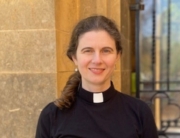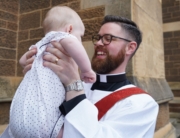Easter 4, 22nd April 2018
The Very Rev’d Frank Nelson
Acts 4: 5 – 12
Psalm 23
1 John 3: 16 – 24
John 10: 11 – 18
One of the oldest, and most beautiful, stained glass windows in this Cathedral is the Good Shepherd window. Given in memory of three year old Joyce Harriet Musgrave, whose father became Governor of South Australia in 1873, you have to come up beyond the choir stalls to see it. It is placed above what is now the sacristy and depicts Jesus as the Good Shepherd, flanked by two angels holding children. The vibrant colours exude warmth and embrace one in the love of God. It’s a window worth having a look at today as we read the Gospel passage from John where Jesus says, “I am the good shepherd.”
Today is also being marked as St George’s Day, though technically the day is tomorrow, 23 April – which also happens to be the birthday of my brother, and William Shakespeare! The red cross on the white background has been the flag of England since the Reformation but widely used long before that, not only at the time of the Crusades but in many parts of Italy. Today it is the central feature of the flag of Georgia.
This morning I want to explore with you a little of these two powerful images – Jesus, the Good Shepherd, and St George, military man and alleged dragon-slayer. They are both well-known and much-loved, which perhaps makes it particularly hard to get beyond the image and the myth and legend. But let’s try.
As I prepared this sermon I had on my desk three little statues, carvings, of shepherds. The first is one I bought in Hong Kong. It depicts an elderly Chinese man dressed in what I imagine was the typical rural clothing somewhere in northern China before the 20th century. A lamb is draped over his shoulders and he holds it by its legs. It is quite unlike our window where Jesus cradles a lamb in his arms, but very similar to another little carving I have, this time from Tanzania. Here too the tall older man drapes the lamb over his shoulders. The third is a bronze given to us after spending three months in south-western Queensland. It shows a young Australian sitting on a log with his left hand resting on his dog. Perhaps more a cattle dog, but a good depiction for me of some of the young farmers I met in that area around Mitchell.
And then I think of some shepherds I have known. My young cousin Peter, probably no more than 10 at the time, carrying a dying lamb, eyes pecked out by crows, a couple of kilometres home. Or similarly aged Tom, who introduced us to his pet lamb Button, and had no hesitation giving us the news that she would one day become Mutton! I have an image of his father unloading the slinkies, one and two day old lambs who had died after a particularly cold night, making a growing pile of little corpses at the farm gate. He challenged me one day on the idea that Jesus, as the Good Shepherd, would bother to seek out the one missing lamb – abandoning the flock that were safe. Just yesterday I read an article about sheep farmers in West Queensland, one of whom spent $500,000 last year erecting a fence against feral dogs in an attempt to lift the survival rate of lambs born to his 15,000 ewes.
Does the image, the metaphor, of Jesus the Good Shepherd work for us who live mainly in the cities and know lamb only as an expensive cutlet at a restaurant, or perhaps as a cute animal at a children’s animal farm?
What of St George? He is a mystery figure with many stories and legends swirling around him. There seems to be some reliability in the idea that he lived towards the end of the 3rd century after Christ, was son of a multi-cultural couple, and was executed when, as a Roman soldier, he refused to take an oath to the emperor. George was well-known and much-revered in places as far afield as Portugal, Moscow and southern India long before he became patron saint of England. Jack Straw, English politician, writing in the Guardian a few years ago had this to say about George: “He was born in Turkey; his mother was Palestinian. He’s so multicultural we have to share him with Lithuania, Portugal, Germany, Greece, Georgia, Moscow, Istanbul, Beirut – and Palestine itself. If he ever came to England, it wasn’t for long.” George is also a revered figure in the Islamic world.
Probably sometime during the Crusades St George became associated with chivalry and under this banner much wonderful work has been done. He is also claimed by ultra-right wing extremists in modern England and in Northern Ireland.
During Lent this year our studies focused on a book by Walter Brueggemann. When I had the privilege of sitting in his lectures a few years ago he constantly spoke about reimagining scripture, reimagining the stories we find there, and the images that spoke to people of other generations and eras. As we know, an image or metaphor is only as strong or useful as the message it conveys. What would happen if we tried to reimagine not only the Good Shepherd but also St George? The first thing to do is to try and get to the essence of what the metaphor was saying in the first place – and not be afraid to look quite deeply and carefully at it, from a number of different angles.
Take Jesus’s claim to be the good shepherd. I suspect that many of us hear that phrase, not in the context of the Gospel as one who puts his life on the line to protect the sheep, but as the gentle pastoral image we get from Psalm 23 – replete with green pastures and still waters. Do we recall the young shepherd boy David who boasted to King Saul that he protected his father’s sheep from lion and bear (1 Samuel 17: 34)? Or the damning passage from the prophet Ezekiel when he accuses the political leaders of his day and says: “You eat the fat, you clothe yourselves with the wool, you slaughter the fatlings; but you do not feed the sheep.” (Ezekiel 34: 1 ff) Or the conversation, so beautifully portrayed in the Lady Chapel windows, when, three times, Jesus asks Peter whether he loves him, and three times tells him to – feed my lambs, feed my sheep. (John 21: 15 ff)
Today’s Gospel passage has Jesus talk about knowing his sheep, and being prepared to lay down his life for them. But he also talks about their being other sheep that do not belong to this fold. Who and where are they? Jesus talks about a very close relationship between himself and ‘the Father’, and his longing to bring all the sheep into one fold, one flock.
Interestingly, in an article in this week’s Church Times newspaper, Michael Collins writes about St George becoming a unifying figure in modern day England. He suggests that the cross of St George takes us back to the fundamentals of Christian faith and belief – that “there is no feast without fast, no celebration without sacrifice — that life in all its profligate abundance is given at a cost and lived at a price.” It always concerns me that so many people flock to church on Easter Day (the feast) without being there during Lent (the fast). Collins goes on to suggest that the cross of St George serves as a reminder that things need to be let go, that the nationalism that once held sway has no place in a modern multi-cultural, multi-lingual, multi-faith society. (Don’t forget that little aside of Jesus about their being other sheep not of this flock.)
And so, briefly, to our other readings this morning. As George would three centuries later, the first Apostles ran into trouble with the authorities. The Book of Acts gives us a fascinating, if somewhat biased, account of the early church –particularly the struggles to put into practice the idea of loving one another, of being open to, and accepting of, people other than our own. Think of Philip and the Ethiopian eunuch (Acts 8: 26 ff), Peter and Cornelius (Acts 10: 1 ff) and the first recorded serious argument in the church mentioned in Acts 15 – the issue over whether or not non-Jewish Gentile Christians had to be circumcised. How do we include these ‘other’ sheep that Jesus talked about in John’s Gospel?
The 1st Epistle of John also deals with the issue of proving one’s love for God by showing love for one another. All very well in theory, it is extraordinarily difficult to do in real life. We so quickly rally around the cross – of Jesus or George – or the –ism that attracts our attention and defines who we are, by definition standing out against the other. We make a bold, perhaps brash, claim on the front page of our service booklets. I have often spoken about it – but it is such a powerful statement, so challenging, that it is worth coming back to time and again, perhaps especially when we think of Jesus the Good Shepherd with his sheep ‘not of this fold’, and the way in which St George has been embraced by people of vastly different beliefs, cultures and languages.
Michael Collins, who I quoted earlier, suggests that as we reimagine St George, we should look again at our parish churches which, he says, “with their rich spiritual and cultural resources and well-established networks, have an essential part to play in the renewal of culture and community proposed in the name of St George.” He may be writing for an English context – but his thoughts are readily transferable into the setting of this Cathedral as we strive to be a Christ-centred, Sacramental, inclusive, thinking, mission-oriented faith community.
Dare we take the Good Shepherd, St George with his red cross and dragon-slaying sword, and reimagine them into a world which is inclusive of all the sheep? Dare we live into the sort of radical new communities envisioned in Acts and the Gospels, where caring for the other, putting the other first, is the norm, not the exception?
Jesus, good shepherd of the sheep, by whom the lost are sought and guided into the fold: feed us and we shall be satisfied, heal us and we shall be whole,
and lead us that we may be with you, where you live and reign with the Father and the Holy Spirit, one God, now and for ever. Amen
APBA Collect for Easter 4





